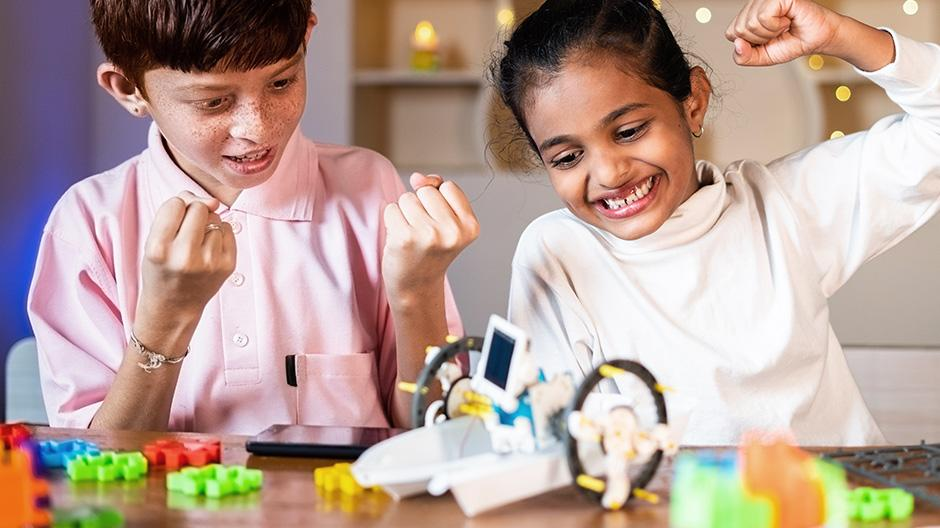Learning vocabulary is one of the most essential steps in your child’s journey toward becoming a strong, consistent reader. But we know it can also be a little daunting for parents to know exactly how to teach vocabulary.
With almost 200,000 words in the English language, where do you even start? Have no fear! Working on vocabulary with your child can be fun and easy, and we’re here to help.
As we work through some playful, effective tips on how to teach vocabulary to your child, there are a couple of pointers we encourage you to keep in mind. These will help you and your child stay focused while still having fun.
Tips On How To Teach Vocabulary
Practice Patience
All children learn at different paces and in their own, unique ways. It may take some time to figure out the perfect mixture of activities to keep your child happy, engaged, and learning.
This is completely normal! What works for your child may be the opposite of what worked for their siblings or their classmates.
Taking the time to adjust to their needs is the best way to keep them engaged and excited about learning new vocabulary.
Encourage Independent Reading
It’s important to foster a sense of confidence and independence in your child from a young age.
Even as they continue to build their vocabulary, it’s helpful to allow your child to explore and grow on their own. They’ll be exposed to plenty of words, subjects, and interests as they navigate through the wonderful world of books.
Your child won’t know every word they come across, even if they’re reading at their reading level, and that’s OK! You’ll be there to help them fill in the gaps.

Get Specific
Teaching vocabulary is all about the nitty-gritty. It’s important to make sure that when your child is learning a new word, they have all the tools they need to thoroughly understand the newest addition to their vocabulary vault.
Working on a single word with detail (and repetition!) helps ensure your child not only knows the word using their recall skills but can also only recognize and comprehend its use.
Help Them Help Themselves
During your child’s exploratory reading sessions, they’re likely to come across some words they don’t know. But that’s no reason for them to struggle!
Teaching your child how to work out words for themselves by using skills they have already mastered — such as sounding-out — will help them on their road to learning and reading independently!
Engage Your Child With Word-Play Games
What’s better than learning techniques that are effective and exciting?
Utilizing word-play games (like the ones below!) can help you figure out how to teach vocabulary to your child in functional and fun ways.
Fun And Easy Activities For Teaching Vocabulary

1) Vocabulary Clue
This game offers an all-star line up of repetitive exposure to vocabulary, providing context clues for your child to use while recalling, and loads of fun while playing!
If you’d like to try this game, you’ll need a list of vocabulary words that you’d like your child to focus on. Write each vocabulary word on a separate slip of paper, then mix them all up in a bowl or hat.
For the first round, you will start by pulling out a vocabulary word. Make sure your child doesn’t see the word!
Next, try to describe the word without actually saying it. Your child’s goal is to guess the word as fast as possible!
We recommend giving players three minutes per word to guess. The younger your child is, the more time they’ll need. That’s OK! You can adapt the timing as you go if you find that your child needs a bit longer to guess.
Keep going and taking turns until you work your way through the bowl of vocabulary words.
For the second round, you use the same vocabulary words, but this time you can only provide clues by acting out the words!
For the third round, you can give verbal hints again, but you and your child can only use one word to hint at what the vocabulary word might be. For example, if the word was “sky,” your hint could be “cloud.”
This game helps make sure that your child has a plethora of resources to help them learn their vocabulary words. After playing, they’ll know the definition of their new vocabulary words as well as synonyms and actions associated with each word!

2) Two Truths And A Lie
This game is easy, quick, and can be used on the go!
For this game, when practicing vocabulary words with your child, provide them with three different options. One option will be the correct definition of the word, while the other two are lies.
We encourage you to be as absurdist and silly as possible!
As you begin, make it obvious which answer is the correct one. As your child gets better and better at recognizing their vocabulary words and the right definition, you can get more advanced with your white lies.
We recommend avoiding switching around the definitions from other vocabulary words they’re focusing on. We don’t want them to get confused!
Sticking with silly, funny white lies will help move them in the right direction.
3) Sticky Ball Game
If you don’t mind sticking some tape on your walls, this is a great game to use for teaching vocabulary!
You can write out each vocabulary word onto a separate flashcard, then stick them onto the wall. Make sure they’re spaced apart! This will make it easier for your child to read.
Next, scrape together a ball made out of tape that’s nice and sticky.
Your job will be to read off the definition of one of the words. Once your child figures out what it is, their goal is to throw the sticky ball at the right word as fast as they can.
For young learners who are still working on their reading skills, you can point to cards and read them off so they have multiple answer choices to consider. Their goal is to throw the ball at the correct answer.
This game is even better if you have multiple kids, as they can play together. Just make sure you adjust the vocabulary to suit each child (don’t act out a word for your sixth grader if it’s your kindergartner’s turn!).
4) Race For The Right Word

You’ll need yourself and one other person to help with this game if you want to give it a go.
One of you should be positioned on one side of the room. Have the other person go to the opposite end of the room and wait with a stack of vocabulary cards written onto large pieces of paper.
Hint: Keep the font a little bit small — the goal is for players to have to run up to the other person to read it!
Once you yell “GO!” your child will dash to the person on the other side of the room holding the flashcard. Then they will run back to you and tell you the definition of the word they saw. Feel free to have the person holding the cards read the words off for younger children.
If your child gets the definition wrong, they can run back to get a hint from the person holding the word. Players can run back and forth as many times as needed to get the definition correct.
You can make this game easier or harder depending on your child’s reading level!
5) Vocabulary “Kamishibai”
This activity might sound fancy, but a kamishibai is just a Japanese form of storytelling that’s done through visual cues. Traditionally, people build tiny “stages” that they use to slide in small pictures representing scenes in a story (think of a very small, mechanical film screen!).
There’s no need to build a stage, but we encourage you to get crafty and creative with this one!
If this sounds like an interesting activity to you, start with a book that your child is familiar with. They should have an understanding of some of the vocabulary they’re trying to practice.
You can illustrate a handful of scenes from the book together that emphasize the vocabulary they’re learning. Give them a head start by reading the book together. Then, ask if they can retell it with the pictures you made together. Can they assemble the story in the right order?
The challenge: can your child tell what picture scene goes with what vocabulary word?
For example, if you’re reading A Very Hungry Caterpillar together, you could draw a picture of the hungry caterpillar turning into a butterfly. This scene could work as an example for vocabulary words like “change” or “transform.”
For younger kids, you can make it even simpler. You could draw a stick figure for the word “man.” Or you could draw a picture of some sneakers for the word “shoe.” It’s easy and adaptable for your child’s learning.
The storytelling and visual aspects of this technique will boost their imagination and recall skills.
Now You Know How To Teach Vocabulary!

Expanding your child’s vocabulary will take time! We hope that one or more of these tips and activities gave you some ideas for making their vocabulary acquisition fun, easy, and a part of their learning routine that they look forward to.
If you ever find yourself needing to mix up your routine, we recommend trying the HOMER app. It has tons of personalized activities for how to teach vocabulary to your child, and help them build confidence that will carry through their reading journey!












